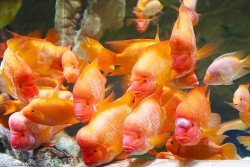Gorillus Black Umbee's Cichlid
 Photo Anger Management Cichlids
Photo Anger Management CichlidsKronoheros umbriferus, often known as the Umbee Cichlid, is a striking and robust freshwater fish species sought after by experienced aquarists and cichlid enthusiasts. Native to Central America, particularly in the waters of Nicaragua and Costa Rica, the Umbee Cichlid is admired for its captivating appearance and intriguing behaviors. In this care guide, we'll delve into essential information about the Umbee Cichlid, including its common name, scientific classification, origin, care requirements, temperament, diet, tank size recommendations, and ideal water parameters.
Lot of 4 Live Gorillus Black Umbee's pure strain Red Freckled Gorillus Umbee's @ 1" plus. I only ship Monday and Tuesday so depending on when you buy them they may not ship out for a few days. I only ship to the lower 48.

Gorillus Black Umbee #4 Video
Quick Facts on Kronoheros Umbriferus
Common Name: Umbee Cichlid
Scientific Name: Kronoheros umbriferus
Species: Umbriferus
Origin: Native to Central America, specifically Nicaragua and Costa Rica.
Size: Umbee Cichlids can reach impressive sizes of up to 14-16 inches (35-40 cm) in captivity.
Care Level: Considered moderate to advanced due to their size and territorial behavior.
Temperament: Umbee Cichlids are known for their semi-aggressive to aggressive temperament, especially during breeding.
Diet: Omnivorous, they thrive on a varied diet consisting of pellets, live or frozen foods, and occasional vegetables.
Minimum Tank Size: A spacious tank of at least 75-100 gallons or larger is recommended for a single Umbee Cichlid.
Temperature: Maintain the water temperature between 76-82°F (24-28°C).
pH Range: Keep the pH level in the range of 6.5-7.5 to provide optimal conditions for Umbee Cichlids.
A Brief Overview
Kronoheros umbriferus, commonly known as the Umbee Cichlid, is a captivating species prized by experienced aquarists for its impressive size, striking appearance, and intriguing behavior. Originating from Central America, specifically Nicaragua and Costa Rica, these cichlids are known for their semi-aggressive to aggressive temperament, particularly during the breeding season. Providing suitable care for Umbee Cichlids involves understanding their habitat, dietary preferences, and reproductive behaviors.
Appearance and Coloration
Umbee Cichlids are visually striking with a robust body and an array of vibrant colors. They typically feature a mix of colors, including shades of blue, green, and red, with distinctive markings on their scales. Males often display more intense colors, especially during breeding. Their powerful appearance and vibrant hues make them a sought-after addition to large cichlid aquariums.
Natural Habitat and Behavior
In their native Central American habitat, Umbee Cichlids inhabit freshwater lakes, rivers, and streams. They are known for their territorial nature, especially when breeding, and will vigorously defend their nesting sites. In the wild, they feed on a varied diet of small fish, crustaceans, and aquatic insects. Understanding their natural behavior is crucial for creating a suitable environment in captivity.
Creating the Perfect Kronoheros umbriferus Habitat
To provide an ideal home for Umbee Cichlids, consider a spacious tank of at least 75-100 gallons with ample hiding spots using rocks, caves, and driftwood. Utilize a substrate of fine sand or smooth gravel to mimic their natural habitat. Maintaining stable water conditions with appropriate filtration and regular water changes is essential for their well-being.
Feeding Kronoheros umbriferus
Umbee Cichlids are omnivorous and thrive on a diet consisting of high-quality cichlid pellets, live or frozen foods like fish, shrimp, and occasional vegetables. Feeding should be done 2-3 times a day with portions they can consume in a few minutes to prevent overfeeding.
Breeding and Reproduction
Breeding Umbee Cichlids can be a rewarding yet challenging endeavor. To encourage breeding, provide them with suitable spawning sites such as flat rocks or ceramic tiles. Maintain slightly higher water temperatures and watch for their natural courtship and spawning behaviors. Once breeding occurs, care for the fry separately, offering them finely crushed flakes and baby brine shrimp.
Frequently Asked Questions
Are Umbee Cichlids suitable for beginners in the aquarium hobby?
Umbee Cichlids are generally better suited for experienced aquarists due to their size and aggressive temperament.
What is the recommended tank size for a pair of Kronoheros umbriferus?
A 75-100-gallon tank or larger is recommended for a pair of Umbee Cichlids to accommodate their territorial nature and potential size.
What are the key indicators of breeding behavior in Umbee Cichlids?
Breeding behavior in Umbee Cichlids includes courtship displays, cleaning and defending a spawning site, and the female laying eggs.
Can Umbee Cichlids coexist with other fish species in a community tank?
Umbee Cichlids are generally best kept with other semi-aggressive or larger cichlid species. Mixing them with smaller or passive fish may result in aggression.
Conclusion
Kronoheros umbriferus, or Umbee Cichlids, are captivating fish species with striking appearances and distinctive behaviors. While they require experienced care due to their territorial nature, providing them with the right habitat, diet, and breeding conditions can lead to a fulfilling and rewarding aquarium experience. Understanding their natural tendencies and meeting their specific needs is key to successfully keeping and breeding Umbee Cichlids in captivity.

